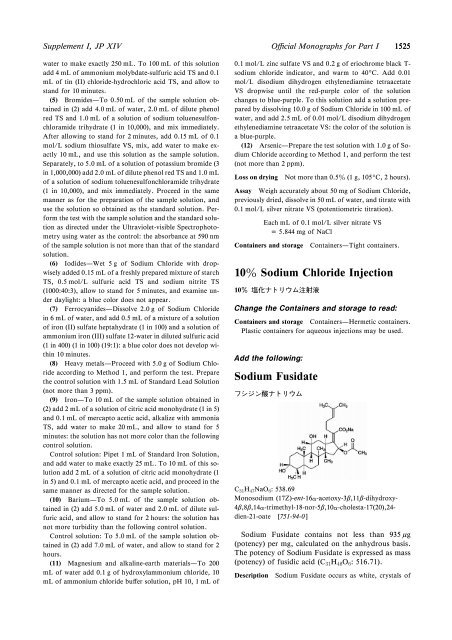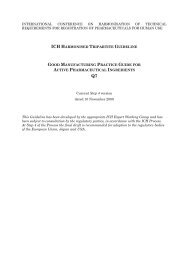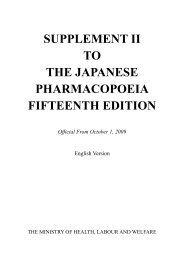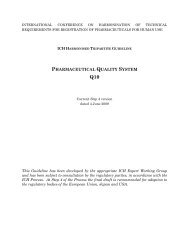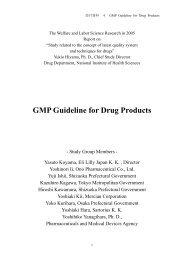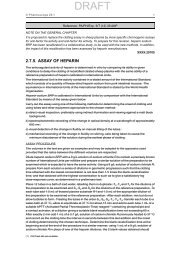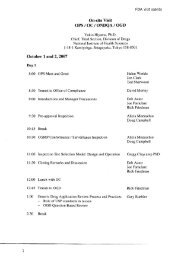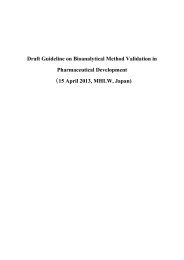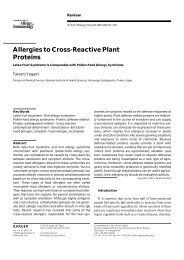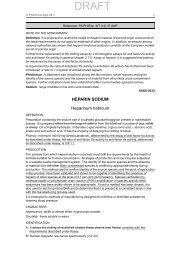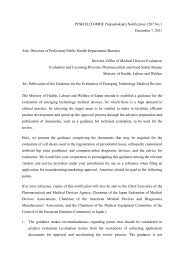Supplement I to the Japanese Pharmacopoeia Fourteenth Edition
Supplement I to the Japanese Pharmacopoeia Fourteenth Edition
Supplement I to the Japanese Pharmacopoeia Fourteenth Edition
You also want an ePaper? Increase the reach of your titles
YUMPU automatically turns print PDFs into web optimized ePapers that Google loves.
<strong>Supplement</strong> I, JP XIV<br />
O‹cial Monographs for Part I<br />
1525<br />
water <strong>to</strong> make exactly 250 mL. To 100 mL of this solution<br />
add 4 mL of ammonium molybdate-sulfuric acid TS and 0.1<br />
mL of tin (II) chloride-hydrochloric acid TS, and allow <strong>to</strong><br />
stand for 10 minutes.<br />
(5) Bromides—To 0.50 mL of <strong>the</strong> sample solution obtained<br />
in (2) add 4.0 mL of water, 2.0 mL of dilute phenol<br />
red TS and 1.0 mL of a solution of sodium <strong>to</strong>luenesulfonchloramide<br />
trihydrate (1 in 10,000), and mix immediately.<br />
After allowing <strong>to</strong> stand for 2 minutes, add 0.15 mL of 0.1<br />
mol/L sodium thiosulfate VS, mix, add water <strong>to</strong> make exactly<br />
10 mL, and use this solution as <strong>the</strong> sample solution.<br />
Separately, <strong>to</strong> 5.0 mL of a solution of potassium bromide (3<br />
in 1,000,000) add 2.0 mL of dilute phenol red TS and 1.0 mL<br />
of a solution of sodium <strong>to</strong>luenesulfonchloramide trihydrate<br />
(1 in 10,000), and mix immediately. Proceed in <strong>the</strong> same<br />
manner as for <strong>the</strong> preparation of <strong>the</strong> sample solution, and<br />
use <strong>the</strong> solution so obtained as <strong>the</strong> standard solution. Perform<br />
<strong>the</strong> test with <strong>the</strong> sample solution and <strong>the</strong> standard solution<br />
as directed under <strong>the</strong> Ultraviolet-visible Spectropho<strong>to</strong>metry<br />
using water as <strong>the</strong> control: <strong>the</strong> absorbance at 590 nm<br />
of <strong>the</strong> sample solution is not more than that of <strong>the</strong> standard<br />
solution.<br />
(6) Iodides—Wet 5 g of Sodium Chloride with dropwisely<br />
added 0.15 mL of a freshly prepared mixture of starch<br />
TS, 0.5 mol/L sulfuric acid TS and sodium nitrite TS<br />
(1000:40:3), allow <strong>to</strong> stand for 5 minutes, and examine under<br />
daylight: a blue color does not appear.<br />
(7) Ferrocyanides—Dissolve 2.0 g of Sodium Chloride<br />
in 6 mL of water, and add 0.5 mL of a mixture of a solution<br />
of iron (II) sulfate heptahydrate (1 in 100) and a solution of<br />
ammonium iron (III) sulfate 12-water in diluted sulfuric acid<br />
(1 in 400) (1 in 100) (19:1): a blue color does not develop within<br />
10 minutes.<br />
(8) Heavy metals—Proceed with 5.0 g of Sodium Chloride<br />
according <strong>to</strong> Method 1, and perform <strong>the</strong> test. Prepare<br />
<strong>the</strong> control solution with 1.5 mL of Standard Lead Solution<br />
(not more than 3 ppm).<br />
(9) Iron—To 10 mL of <strong>the</strong> sample solution obtained in<br />
(2) add 2 mL of a solution of citric acid monohydrate (1 in 5)<br />
and 0.1 mL of mercap<strong>to</strong> acetic acid, alkalize with ammonia<br />
TS,addwater<strong>to</strong>make20mL,andallow<strong>to</strong>standfor5<br />
minutes: <strong>the</strong> solution has not more color than <strong>the</strong> following<br />
control solution.<br />
Control solution: Pipet 1 mL of Standard Iron Solution,<br />
and add water <strong>to</strong> make exactly 25 mL. To 10 mL of this solution<br />
add 2 mL of a solution of citric acid monohydrate (1<br />
in 5) and 0.1 mL of mercap<strong>to</strong> acetic acid, and proceed in <strong>the</strong><br />
same manner as directed for <strong>the</strong> sample solution.<br />
(10) Barium—To 5.0 mL of <strong>the</strong> sample solution obtained<br />
in (2) add 5.0 mL of water and 2.0 mL of dilute sulfuric<br />
acid, and allow <strong>to</strong> stand for 2 hours: <strong>the</strong> solution has<br />
not more turbidity than <strong>the</strong> following control solution.<br />
Control solution: To 5.0 mL of <strong>the</strong> sample solution obtained<br />
in (2) add 7.0 mL of water, and allow <strong>to</strong> stand for 2<br />
hours.<br />
(11) Magnesium and alkaline-earth materials—To 200<br />
mL of water add 0.1 g of hydroxylammonium chloride, 10<br />
mL of ammonium chloride buŠer solution, pH 10, 1 mL of<br />
0.1 mol/L zinc sulfate VS and 0.2 g of eriochrome black T-<br />
sodium chloride indica<strong>to</strong>r, and warm <strong>to</strong> 409C. Add 0.01<br />
mol/L disodium dihydrogen ethylenediamine tetraacetate<br />
VS dropwise until <strong>the</strong> red-purple color of <strong>the</strong> solution<br />
changes <strong>to</strong> blue-purple. To this solution add a solution prepared<br />
by dissolving 10.0 g of Sodium Chloride in 100 mL of<br />
water, and add 2.5 mL of 0.01 mol/L disodium dihydrogen<br />
ethylenediamine tetraacetate VS: <strong>the</strong> color of <strong>the</strong> solution is<br />
a blue-purple.<br />
(12) Arsenic—Prepare <strong>the</strong> test solution with 1.0 g of Sodium<br />
Chloride according <strong>to</strong> Method 1, and perform <strong>the</strong> test<br />
(not more than 2 ppm).<br />
Loss on drying<br />
Not more than 0.5z (1 g, 1059C, 2 hours).<br />
Assay Weigh accurately about 50 mg of Sodium Chloride,<br />
previously dried, dissolve in 50 mL of water, and titrate with<br />
0.1 mol/L silver nitrate VS (potentiometric titration).<br />
Each mL of 0.1 mol/L silver nitrate VS<br />
= 5.844 mg of NaCl<br />
Containers and s<strong>to</strong>rage<br />
Containers—Tight containers.<br />
10z Sodium Chloride Injection<br />
10 塩 化 ナトリウム 注 射 液<br />
Change <strong>the</strong> Containers and s<strong>to</strong>rage <strong>to</strong> read:<br />
Containers and s<strong>to</strong>rage Containers—Hermetic containers.<br />
Plastic containers for aqueous injections may be used.<br />
Add <strong>the</strong> following:<br />
Sodium Fusidate<br />
フシジン 酸 ナトリウム<br />
C 31 H 47 NaO 6 :538.69<br />
Monosodium (17Z)-ent-16a-ace<strong>to</strong>xy-3b,11b-dihydroxy-<br />
4b,8b,14a-trimethyl-18-nor-5b,10a-cholesta-17(20),24-<br />
dien-21-oate [751-94-0 ]<br />
Sodium Fusidate contains not less than 935 mg<br />
(potency) per mg, calculated on <strong>the</strong> anhydrous basis.<br />
The potency of Sodium Fusidate is expressed as mass<br />
(potency) of fusidic acid (C 31 H 48 O 6 : 516.71).<br />
Description<br />
Sodium Fusidate occurs as white, crystals of


